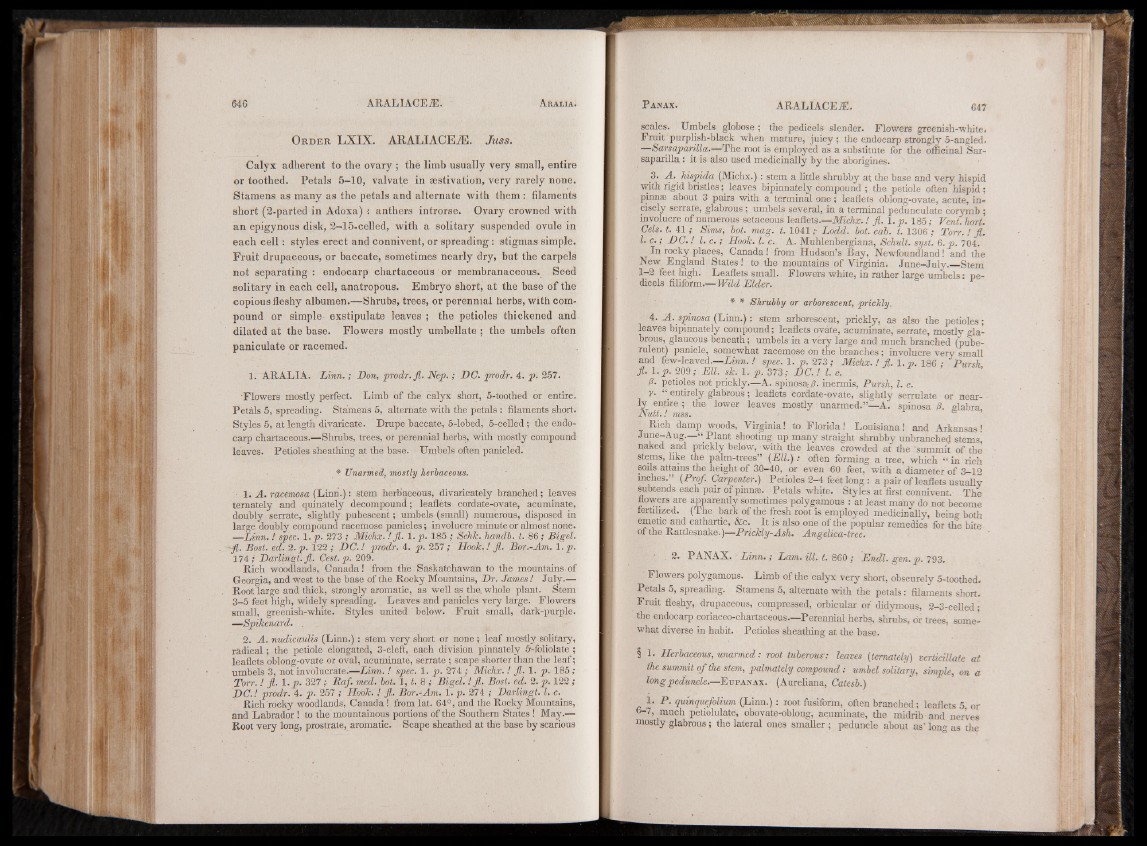
Order LXIX. ARALIACEiE. Juss.
Calyx adherent to the ovary ; the limb usually very small, entire
or toothed. Petals 5-10, valvate in aestivation, very rarely none.
Stamens as many as the petals and alternate with th em : filaments
short (2-parted in Adoxa) : anthers introrse. Ovary crowned with
an epigynous disk, 2-15-celled, with a solitary suspended ovule in
each c e l l : styles erect and connivent, or spreading: stigmas simple.
Fruit drupaceous, or baccate, sometimes nearly dry, but the carpels
not separating : endocarp chartaceous or membranaceous. Seed
solitary in each cell, anatropous. Embryo short, a t the base o f the
copious fleshy albumen.—Shrubs, trees, or perennial herbs, with compound
or simple exstipulate leaves ; the petioles thickened and
dilated a t the base. Flowers mostly umbellate; the umbels often
paniculate or racemed.
1. ARALIA. L in n .; Don, prodr. fl. Nep.; DC. prodr. 4. p. 257.
Flowers mostly perfect. Limb of the calyx short, 5-toothed or entire.
Petals 5, spreading. Stamens 5, alternate with the petals : filaments short.
Styles 5, at length divaricate. Drupe baccate,- 5-lobed, 5-celled; the endocarp
chartaceous.—Shrubs, trees, or perennial herbs, with mostly compound
leaves. Petioles sheathing a.t the base. Umbels often panicled.
* Unarmed, mostly herbaceous.
1. A. racemosa (Linn.): stem herbaceous, divaricately branched; leaves
ternately and quinately decompound; leaflets cordate-ovate, acuminate,
doubly serrate, slightly pubescent; umbels (small) numerous, disposed in
large doubly compound racemose panicles; involucre minute or almost none.
—L in n .! spec. 1. p. 273 ; Michx. ! fl. 1. p. 185; Schk. handb. t. 86 ; Bigel.
■fl. Bost. ed. 2 .p. 122 ; DC.! prodr. 4. p. 257; Hook.! fl. Bor.-Am. 1. p.
174 ; Darlingt. fl. Cest. p. 209.
Rich woodlands, Canada! from the Saskatchewan to the mountains of
Georgia, and West to the base of the. Rocky Mountains, Dr. James ! July.—
Root, large and thick, strongly aromatic, as well as the. whole plant. Stem
3-5 feet high, widely spreading. Leaves and panicles very large. Flowers
small, greenish-white. Styles united below. Fruit small, dark-purple.
—Spikenard. .
2. A. nudicaulis (Linn.): stem very short or none ; leaf mostly solitary,
radical; the petiole elongated, 3-cleft, each division pinnately 5-foliolate ;
leaflets oblong-ovate or oval, acuminate, serrate ; scape shorter than the leaf;
umbels 3, not involucrate.—Linn. ! spec. 1. p. 274 ; Michx. ! fl. 1. p. 185;
Torr.! fl. 1. p. 327 ; Raf. med. hot. 1, t. 8 ; Bigel. ! fl. Bost. ed. 2. p. 122 ;
DC.! prodr. 4. p. 257; Hook. / fl. Bor.-Am. 1. p. 274 ; Darlingt. 1. c.
Rich rocky woodlands, Canada! from lat. 64°, and the Rocky Mountains,
and Labrador ! to the mountainous portions of the Southern States ! May.—
Root very long, prostrate, aromatic. Scape sheathed at the base by scarious
scales. Umbels globose ; the pedicels slender. Flowers greenish-white.
Fruit purplish-black when mature, juicy; the endocarp strongly 5-angled.
—Sarsaparilla.—The root is employed as a substitute for the officinal Sarsaparilla
: it is also used medicinally by the aborigines.
.3. A. hispida (Michx.): stem a little shrubby at the base and very hispid
with rigid bristles; leaves bipinnately compound ; the petiole often hispid;
pinnae about 3 pairs with a terminal one; leaflets oblong-ovate, acute, in-
cisely serrate, glabrous ; umbels several, in a terminal pedunculate corymb ;
involucre of numerous setaceous leaflets.—Michx.! fl. I . p. 185; Vent.hort.
Cels. t. 41; Sims, hot. mag. t. 1041,- Lodd. hot. cab. t. 1306 ; Torr. ! fl.
1. c .; DC. ! 1. c .; Hook. 1. c. A. Muhlenbergiana, Schult. syst. 6. p. 704.
In rocky places, Canada! from Hudson’s Bay, Newfoundland! and the
New England States! to the mountains of Virginia. June-July.__Stem
1-2 feet high. Leaflets small. Flowers white, in rather large umbels: pedicels
filiform.— Wild Elder.
* * Shrubby or arborescent, prickly.
4. A . spinosa (Linn.): stem arborescent, prickly, as also the petioles;
leaves bipinnately compound; leaflets ovate, acuminate, serrate, mostly glabrous,
glaucous beneath; umbels in a very large and much branched (pube-
rulent) panicle, somewhat racemose on the branches; involucre very small
and few-leaved.— Linn. ! spec. 1 . p. 273; Michx. ! f l . 1 . p. 186 ; Pursh fl. l .p . 209; Elk sk. 1. p. 373; D C .! 1.6.
0. pqtioles not prickly— A. spinosa.0. inermis, Pursh, l. c.
y. “ entirely glabrous; leaflets cordate-ovate, slightly serrulate or nearly
entire ; the lower leaves mostly unarmed.”—A. spinosa 0. glabra
Nutt.! mss.
Rich damp woods, Virginia! to Florida! Louisiana! and Arkansas!
June-Aug.—“ Plant shooting up many straight shrubby unbranched stemsj
naked and prickly below, with the leaves crowded at the summit of the
stems, like the palm-trees” (E ll.): often forming a tree, which “ in rich
soils attains the height of 30-40, or even 60 feet, with a diameter of 3-12
inches.” (Prof. Carpenter.) Petioles 2-4 feet long: a pair of leaflets usually
subtends each pair of pinnae. Petals white. Styles at first connivent. The
flowers are apparently sometimes polygamous : at least many do not become
fertilized. (The bark of the fresh root is employed medicinally, being both
emetic and cathartic, &c. It is also one of the poptdar remedies for the bite
of the Rattlesnake.)—Prickly-Ash. Angelica-tree.
• PANA X. Linn. ; Lam. ill. t. 860 ; Endl. gen. p. 793.
Flowers polygamous. Limb of the calyx very short, obscurely 5-toothed,
Petals 5, spreading. Stamens 5, alternate with the petals: filaments short.
Fruit fleshy., drupaceous, compressed, orbicular or didymous, 2-3-celled;
the endocarp coriaceo-chartaceous.—Perennial herbs, shrubs, or trees, somewhat
diverse in habit. Petioles sheathing at the base.
§ 1. Herbaceous, unarmed: root tuberous: leaves (ternately) verticillate at
the summit of the stem, palmately compound: umbel solitary, simple, on a
long peduncle— E upanax. (Aureliana, Catesb.)
1. P. qumquefolium (Linn.): root fusiform, often branched; leaflets 5 or
6-7, much petiolulate, obovate-oblong, acuminate, the midrib and nerves
mostly glabrous; the lateral ones smaller ; peduncle about as' long as the